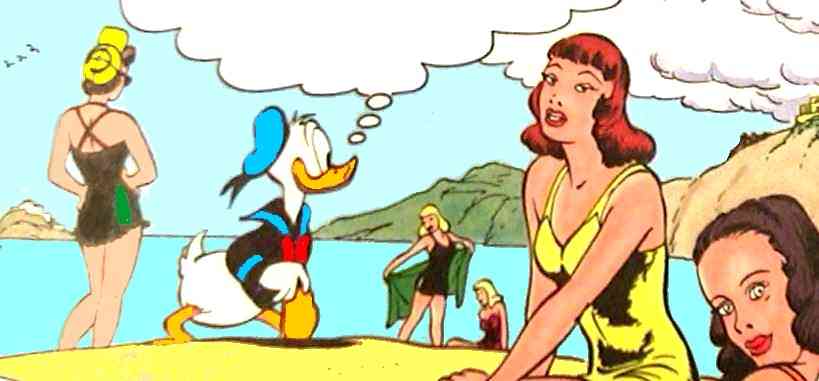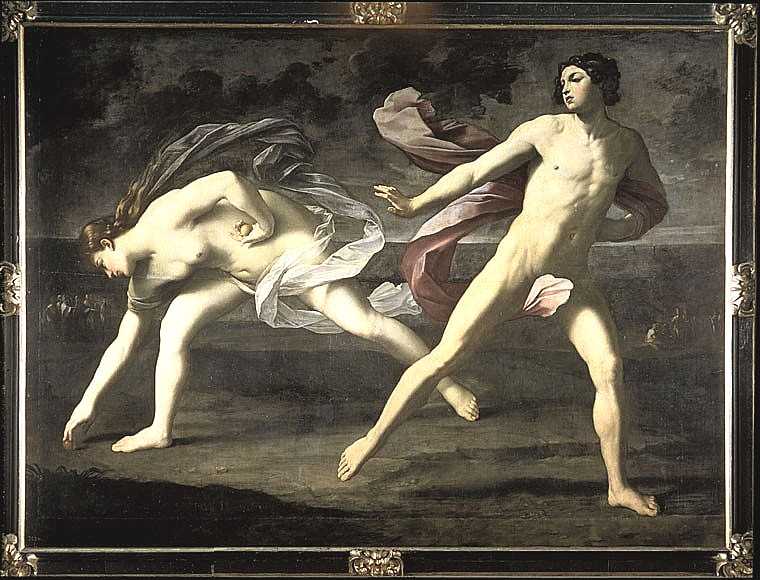

Although Barks was very conscious - in his own words 'toothshatteringly careful' - about the possibility of censorship of his comics, he only encountered a few incidents in which his editor overruled him. This was unavoidable, of course, as Barks produced well over 50,000 panels in his time. The censoring came from a vague and over-scrupulous morals code that became enforced more and more vigorously during the late 1950's and the first part of the 1960's. However it did kill off some worthy projects.
GENERAL
Barks knew nothing of how the comics code (the Dell
pledge) at Western worked until long after he started at the
company. It wasn't until late May 1954 that Western finally
produced a list of unwelcome and even some forbidden subjects.
Here are some of them: no mentioning or showing of death, no
excessive violence, no unnecessary pain, no adult themes, no sex
and no making fun of lawmen or showing of crooked lawmen and so
on and so forth.
Barks recalls: I didn't experience much censorship, because I
was very careful. I didn't know much about the comics code, and
Western didn't give me much direction. It was years after I'd
made a few mistakes that I found out that they had a list of
taboos. You couldn't use the word 'kill' or use a gun in a
dangerous way, and you couldn't have poison or sickness or
crippled people. But after six years in the Disney Studio story
department, I had already absorbed quite a few of those do's and
don'ts...
EXAMPLES
(Chronologically
listed after dates of issue)
| 1943 WDCS033 This story in which Donald Duck acts as a life guard for a beautiful lady-duck marks Barks' first run-in with the editor. He had drawn the lady fully equipped with voluptuous breasts but was told to remove them. The end result is especially apparent in this picture where the bodies are quite inexplicably not touching each other. |
SEX |
|
DISCRIMINATION |
1943
WDCS034 Donald Duck tries to do good deeds which brings him into a close encounter with a hostile duck-negro-tribe. The editor said he would not in the future accept black ducks as that might seem racist in the duck universe. |
|
| 1945
(WDCS064) In 1945 Barks drew a 10-page Christmas story intended for WDCS064 and titled Silent Night, in which Donald Duck quarrels with neighbour Jones while he and the nephews are attempting to sing carols. In the closing scene Donald is tortured with an electric cattle prod. The editor found the story far too violent and it was not published. |
|
|
CRIME |
1946 FC0108 Originally, the story ended when Donald Duck was jailed for burning the courthouse down to the ground. But as it was not considered proper to show a classic Disney character behind bars following a crime, the last two panels were redrawn by another artist thus achieving a much weaker and uninteresting ending. |
| 1946
FC0203 In The Golden Christmas Tree a witch is coincidentally killed as she falls from a cliffside while trapped in an oil can. Barks' original ending was that Donald Duck accidentally pushed the witch to her death, but that situation was not acceptable to the editor. |
HOMICIDE |
|
HORROR |
1949
FC0238 In Voodoo Hoodoo Barks had drawn the zombie with open and impassive eyes but the editor felt that the creature should have pupils and half-closed eyelids instead in order not to scare the young readers too much. In later reprints the ring in his nose was also removed. |
|
| 1951 FC0308 Barks found great pleasure in drawing real people - i.e. characters without animal features - into his stories although the editor did not like it. In Dangerous Disguise Barks finally went too far as all the non-duck characters were real people. I was in deep trouble, Barks later shuttered. But due to an upcoming deadline the story was accepted... |
 PEOPLE |
 JEALOUSY |
1952
(WDCS144) In 1952 Barks made another 10-page story intended for WDCS144 and titled The Golden Apples but it was vetoed by the editor. It has been lost since then. To the best of Barks' recollection it was based on the Greek myth of The Apples of the Hesperides, and took place during an apple festival at which Daisy appeared as a jealous and crusty battleaxe and that got it rejected. |
|
| The myth tells about Hera who received the golden apples - which secures immortality - as a wedding gift from Zeus. The nymph Atalanta, a strong athlete, was immensely popular among the young men for her good looks, but she vowed that she would forever maintain her independence. Thus she challenged all the lovesick youngsters to races in which the losers were to be killed. Atalanta won easily every time until one day when Hippomenes dropped the golden apples in the track during the race. The nymph stopped to collect the fruits resulting in her defeat. | ||
MORTALITY |
EERINESS (APPROVED) |
1952 DD26 In Trick or Treat Barks opened with a splash panel showing Duckburg as seen from a cemetery as a witch flies over the town on her broom. The story was based on an animated short by the same name and with the same opening scene but the editor objected as he said that in a comic book the children would have time to dwell on the cemetery scene and that would not be wholesome. Barks then drew another splash panel but in later reprints the original version is often chosen. |
|
KIDNAPPING |
1953
FC0456 Barks received a lot of criticism for Back to the Klondike as it broke several different taboos. A halfpage panel showing a bar room brawl was deemed too violent and Glittering Goldie seemed to show an unbecoming greed for gold. Furthermore Uncle Scrooge had kidnapped the girl and forced her to work at his claim. The fact that they lived together in a small hut for many weeks, (which suggested that the two might have been lovers) was not exactly helpful either. |
| 1956 U$12 Uncle Scrooge encounters five fantasy birds from Greek mythology. Barks called them Harpies, as they were indeed called in mythology, but he was asked to change their names to Larkies, as the editor thought that in some corners of USA the name Harpies was slang for ladies of the night. He was also told to change two panels in which the bird-ladies acted insanely. |
SLANG |
VIOLENCE |
1957 (WDCS196) Even as late as 1957 Barks wrote a 10-pager which was deemed unsuitable for publication. It was intended for WDCS196 and would - to the best of Barks' recollection - have been titled Bobsled Race. The plot circled around violent arguements between Donald Duck and the nephews. One year before the editor had warned Barks that he was to tone down the violent relationship between the two parties as a direct result of a complaint from a mother. She had objected to Donald saying 'Shut up' to his nephews in the closing panel of WDCS186. |
During those years Western (Dell) printed a sticker on all their comic books with the following pledge:: Dell Comics Pledge To Parents: |
|
| 1957 (WDCS215) The same year another 10-pager intended for WDCS 215 was shelved. It was simply archived as The Milkman Story and it tells a tale about Donald Duck being a perfect milkman until he becomes extremely violent and revengeful towards a very irritating customer. The story was finally published in WDCS550 in 1990 after having been published several places in Europe. |
REVENGE |
THOUGHTLESSNESS |
1962 WDCS259 The splash panel of this story originally showed Donald Duck shooting a prune off of a tall pole with his bow and arrow. The pole is held upright by the nephews and the editor felt - no doubt correctly - that the young readers might venture into something like that themselves. Consequently Barks altered the panel and showed all three nephews standing alongside Donald as he shoots. |
| 1966 U$65 The
editor received a synopsis of the story House of
Haunts before Barks began the work. In it he had
the Beagle Boys learn about crime in jail. It was
immediately altered into showing the boys learning good
deeds at a diploma school in the prison instead. |
NEGATIVITY |
EXTRAORDINARY
During
the 1950s the US postal service enforced a peculiar demand saying,
that comic magazines sent as second class mail were to contain a
minimum of two stories and none of the characters were allowed to
appear in both!
Because of this rule, the Uncle Scrooge story Land
Beneath the Ground (U$13) in the
American issue was reduced from 32 to 27 pages in order to make
room for a 4-pager starring Gyro Gearloose fighting with the
elements during a rainstorm. But even that was not enough as Huey,
Dewey and Louie starred in both stories. Thus the nephews were
replaced by Morty and Ferdy from the Mickey Mouse universe.
Yet another example occurred in the U$14 Gyro
Gearloose story in which Donald Duck had to be erased and a new
forgettable character was drawn in his place!
| http://www.cbarks.dk/THECENSORSHIP.htm | Date 2002-10-22 |